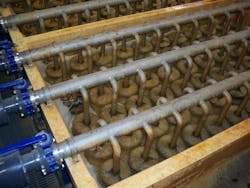Achieving Zero Liquid Discharge
A power plant in the Southwest recently was required to move to zero liquid discharge (ZLD) because the existing land it used for disposal—via spray irrigation—no longer would be available. The Department of Transportation had decided to build a highway through the existing fields. For the power plant to minimize its dependence on spray irrigation, a creative solution was needed to treat the challenging cooling tower blowdown water (CTBW).
Project Background
ZLD at power plants always has been difficult due to the challenge of treating CTBW. Power plants often produceCTBW streams that have very high silica concentrations, usually at or near their solubility limit. This makes treatment of CTBW difficult with reverse osmosis (RO) due to the high scaling potential. CTBW often is applied to large land areas (e.g., irrigation fields, evaporation ponds) or treated with some type of energy-intensive and costly thermal evaporation process. A new approach to CTBW treatment is to utilize a precipitation process followed by ultrafiltration (UF) and RO.
If a precipitation-UF process is able to remove a large percentage of the sparingly soluble salts, then the RO system can be designed for a higher operating recovery, creating a smaller brine stream for the power plant to manage. There are numerous methods that can be used to precipitate out sparingly soluble salts, but the key is to employ a process that is reliable and effective to ensure certain dissolved solids are removed before RO.
System Design
The goal of the project was to recover as much CTBW for reuse as possible, thus minimizing the volume of brine to handle. If the CTBW can be recovered and treated to a high-enough quality, then the resulting product can be reused as part of the boiler makeup system. Not only does this help the power plant deal with its wastewater problem, but it also allows the plant to reduce its freshwater consumption by reusing the reclaimed water.
The source of the cooling tower makeup water is a combination of well water and tertiary-treated water from a local wastewater treatment plant. The maximum allowable silica concentration inside the cooling towers with the use of scale inhibitors is 225 mg/L. The cycles of concentration inside the cooling towers are kept below 6.6.
CTBW is collected from the five different cooling towers at the plant and into a 1-million-gal storage tank, which directly feeds the precipitation-UF-RO system. Total flow to the treatment plant is 720 gal per minute (gpm), and it is split into two trains.
Once the sparingly soluble salts have been oxidized and/or precipitated, they are removed easily by a UF membrane. Due to the nature of the precipitation process, the total suspended solids of the CTBW increases dramatically and can be as high as 2,900 mg/L.
The submerged UF system consists of two 360-gpm trains using SpiraSep spiralwound UF membranes with a 0.03-micron polyethersulfone chemistry. The UF system utilizes negative pressure to “pull” water through the membrane at a design rate of 12 gal per square foot per day, consuming low amounts of energy while reducing membrane fouling. Air is fed up through the membrane channels, actively scouring the surface and removing particulate matter from the UF modules.
Periodically, the UF membranes are mechanically cleaned by backwashing with UF permeate. A complete barrier layer is provided by the 0.03-micron membrane that reduces the turbidity to less than 0.1 NTU. The ultra-low effluent turbidity is critical in preventing fouling in the RO system. A concentrated reject stream is sent to a dewatering process in which the recovered water is sent back to the UF influent, resulting in an overall recovery rate of greater than 99% through the UF.
In order for the precipitation-UF-RO process to be viable, the silica concentration needs to be lowered to less than 45 mg/L, with a target of 25 mg/L, as this corresponds to recommended maximum feed silica concentration to an RO system operating at high recovery for this particular water source. While some initial tests have shown that silica reduction levels greater than 95% are possible, additional studies are being performed to optimize the precipitation process so that a consistent and reliable silica removal rate is achieved.
With a target silica concentration of less than 45 mg/L in the UF effluent, RO now can be employed and operated at a high recovery. The RO system was divided into two trains, each designed to produced 288 gpm at 80% recovery. Although the design recovery is 80%, it is possible to operate the RO system at higher recoveries, though there is an increased risk of CaSO4 and SiO2 scaling when doing so. The design target for RO permeate total dissolved solids is less than 125 mg/L.
Conclusion
Recovery of cooling tower blowdown can be an expensive proposition with some of the conventional approaches available today. Due to the high salt content of most CTBW, it is difficult for RO systems to recover large percentages of this wastewater stream.
With a new approach of precipitating sparingly soluble salts, and subsequent removal using UF, a large percentage of the scaling potential can be removed from the process, allowing an RO system to operate at high recovery rates.
Additional work will be required to determine the most effective method for handling the remaining brine solution from the RO system, but several possibilities exist and the task becomes more manageable with the greatly reduced brine volume.
Download: Here
